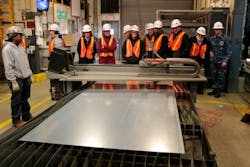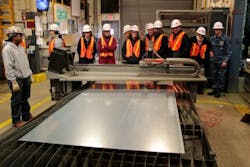Fabricating lab uses laser cutting as a training tool
Norfolk, VA - DARPA and the US Navy are developing advanced fab facilities for less supply line dependence. High-tech fabrication facilities are being developed to enhance ship maintenance and repair by enabling more cost-effective training and rapid onsite production of parts and components.
They recently agreed to create a laser cutting-equipped fabrication laboratory, or Fab Lab, at the Mid-Atlantic Regional Maintenance Center (MARMC) in Norfolk, VA, under DARPA's Manufacturing Experimentation and Outreach Two (MENTOR2) program. The Fab Lab installation and initial operation is expected in April 2015.
The goal of MENTOR2 is to reduce logistics supply chain costs and boost defense readiness by improving training and tools for operating, maintaining, and adapting complex military equipment in low-tech environments—for example, repairing unmanned aerial vehicles in austere locations or fixing ship systems at sea. Some machine shops and fabrication capabilities exist aboard ships and in deployed areas, but these facilities provide only a fraction of the components needed for deployed operations—largely due to limited access to the adaptive manufacturing technology and comprehensive design expertise needed for in-theater fabrication. MENTOR2 aims to provide troops advanced tools and training, so they can rapidly design and fabricate needed components on the spot.
Fab Labs are design and fabrication shops outfitted with modern digital tools and equipment—such as laser cutters, routers, 3D printers, vinyl cutters for flexible circuit boards, and digital design tools that use open-source software. DARPA is establishing the Navy's customized Fab Lab through the Fab Foundation, a non-profit organization that oversees the international Fab Lab Network, a collaborative, knowledge-sharing community of more than 450 Fab Labs in 55 countries. The Fab Labs came out of the Massachusetts Institute of Technology (MIT)'s Center for Bits and Atoms in 2001. The vision for a Fab Lab at MARMC is to provide ship maintainers with training on state-of-the-art fabrication tools, so they can create unique components or training aids much faster and at lower cost than is possible today.
"We're excited to team with the Navy to bring cutting-edge design and fabrication tools and training to a large regional ship maintenance facility," says Gill Pratt, program manager in DARPA's Defense Sciences Office. "Military maintainers are incredibly resourceful and creative in austere deployed locations and at sea far from fabrication or repair facilities. They are pros at adapting what they have to get the mission done. But beyond the need to facilitate quick repairs, we hope that by training Sailors on Fab Lab equipment they'll be better able to convert their innovative ideas into designs and rapid prototypes that could be certified for wider fleet use. Prototype component designs potentially could be shared digitally across the Navy, and perhaps result in Fab Labs being established in other military locations."
Navy leaders at MARMC say they foresee significant benefits from having modern training and tools on hand for ship maintenance and repair.
"Hosting the first Navy Fab Lab at MARMC is a great partnership with DARPA," says Lt. Todd Coursey, MARMC project officer. “We're working with DARPA to develop curriculum and certification to support our Warfighters—working to heighten their understanding of high-technology systems and how to use advanced digital fabrication and computation tools to maintain and adapt ship systems. One of our desired outcomes is to develop a condensed additive manufacturing workforce training curriculum that could be sourced to Fleet and other Department of Defense personnel—truly enabling a more adaptive and innovative workforce."
They have a 2000-sq-ft. technical prototyping platform complete with off-the-shelf, industrial-grade fabrication and electronics tools. Fab Lab is a platform for learning and innovating, a place to create, learn, mentor, and develop. MENTOR-2 will provide on-site technical training for the Fab Lab technicians and managers, as well as installation of the Fab Lab in the MARMC production shop.
A substantial portion of the Department of Defense (DoD) budget is spent on training personnel to maintain highly complex electromechanical systems, often in austere environments where long logistical supply chains challenge the ability to obtain spare parts in a timely manner. Today's DoD deploys some machine shops and other fabrication capabilities in-theater, but these facilities provide only a small fraction of needed components. This is largely due to limited access to the adaptive manufacturing technology and comprehensive design expertise necessary for in-theater manufacturing.
DARPA's Manufacturing Experimentation and Outreach Two (MENTOR2) program seeks to enhance defense readiness by improving both the training and the tools available to those who will be called on to utilize, maintain, and adapt high-technology systems in low-technology environments. MENTOR2 will pursue this goal by developing and demonstrating new training tools, new materials, and new manufacturing technologies in the fields of electromechanical design and manufacturing. It is envisioned that project-based curricula employing MENTOR2 design and prototyping tools will teach a deeper understanding of high-technology systems and better enable future competence in the maintenance and adaptation of such systems through the manufacture of as-designed components or the design and manufacture of new components.

